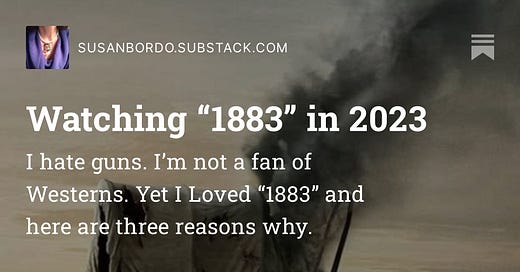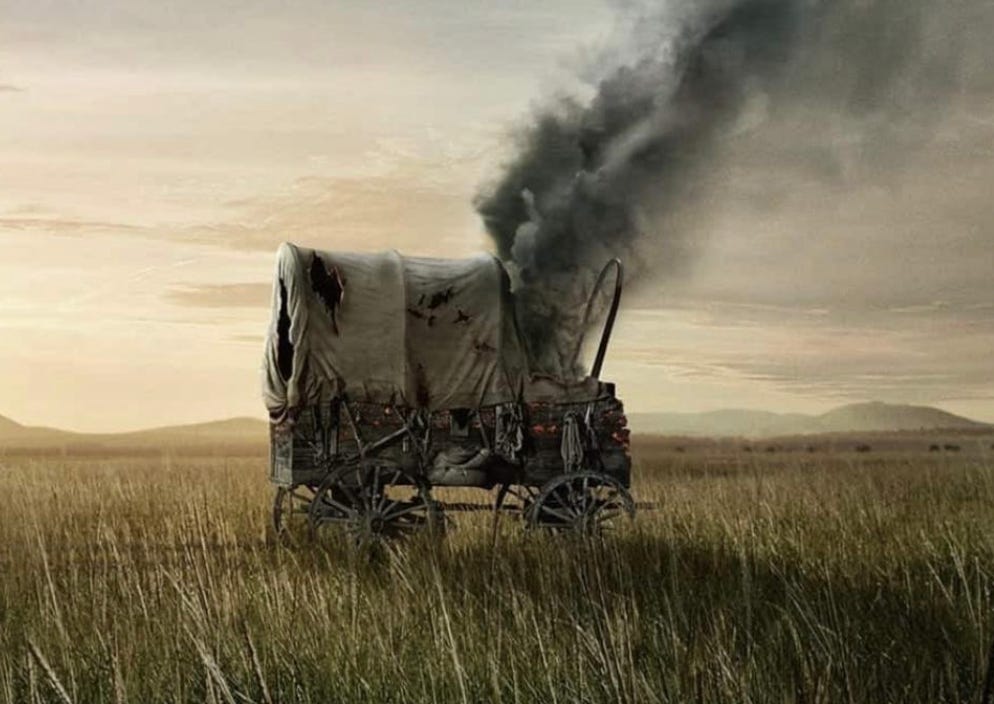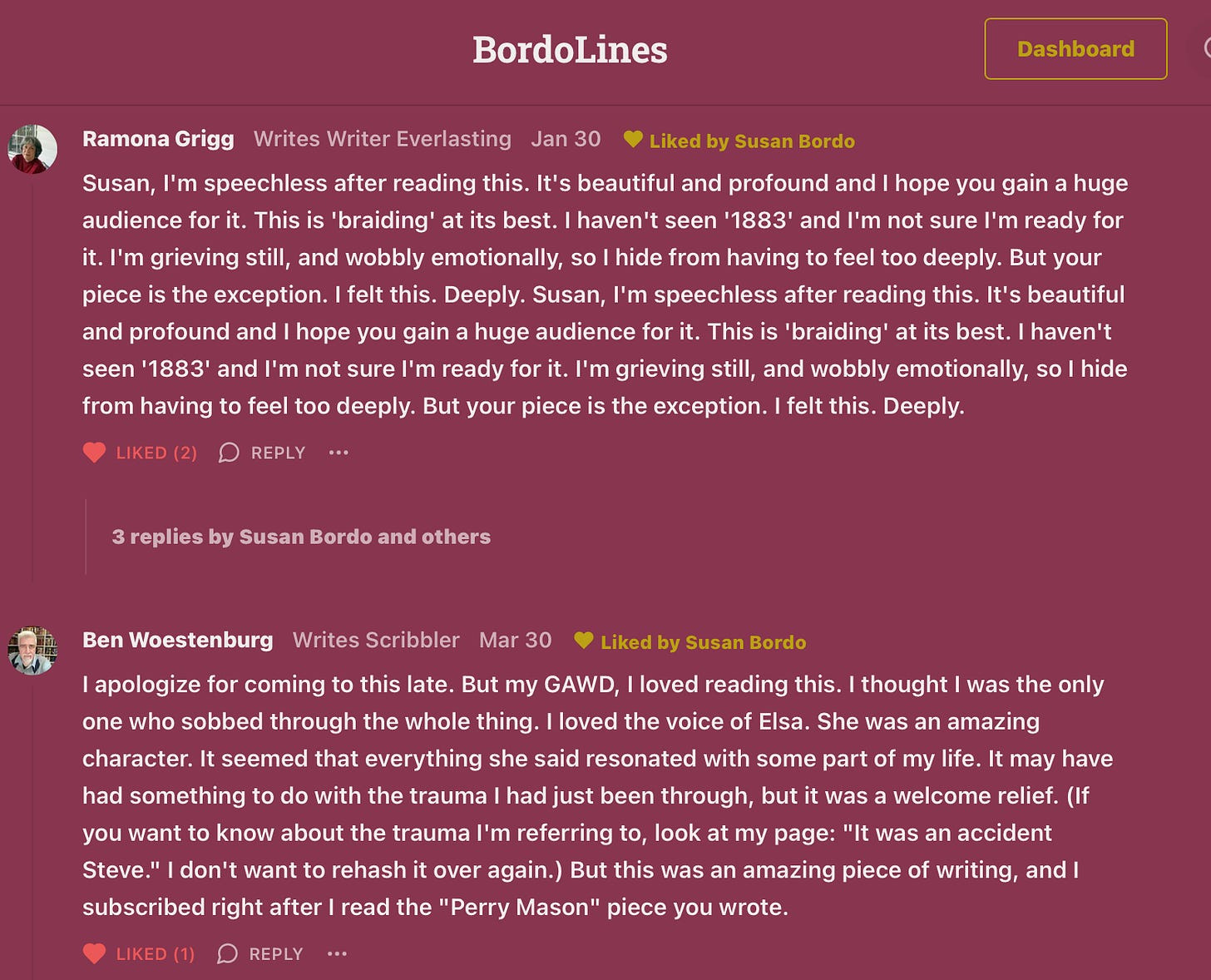In Case You Missed It: Watching “1883” in 2023
If you’re feeling series-deprived, this is a great one and will be streaming on Paramount starting June 18th.
(This piece was originally published January 25)
1. Demons are Everywhere.
After two days of an 1883 binge, I’ve been having a look at the reviews. None of them seem to connect emotionally with the series the way I did. The ones that like it praise the sweep, the landscapes, the acting. Those that don’t like it correct the historical blunders, criticize the fact that it’s yet again drama from the white man’s point of view, focus on the cliches of the cowboy genre. I can’t quarrel with the praise or the criticism. But when something moves me, maudlin doesn’t matter and neither does political correctness or historical accuracy. If you watch 1883 attuned to those, there is much to find fault with: The constant shoot-em-ups and what is presented as a justified gun culture, the well-worn archetypes of noble (and here, very sexy) “Indians,” strong, mostly silent men who (when they do talk) deliver pithy truths, superwomen who know how to shoot and ride like men—with makeup fully intact. And a narration whose poetic language and philosophical musings are at times so deliberately, poetically profound as to be cringey.
I’ve heard that MAGAs love the series, and I can see why. The immigrants (although I’m sure some are “very fine people”) are incompetent and unprepared for life in America, and don’t even know how to swim or shoot a gun. The insurgents who stormed the capital can imagine that they, like the early settlers, were only fighting for their lives and values: freedom from the “tyranny” of man-made laws, self-reliance, and the right to improvise the moral rules. In 1883 having a gun—many guns—is essential to survival. “This place’ll pick you apart if you haven’t got one,” a Fort Worth Texan tells James Dutton, travelling with his family across what the synopsis for the series calls the “last bastion of untamed America.” “But if you pull your pistol in this town, mister,,,You better know how to use it.” And everyone, it seems, does.
From the very opening sequence, however, creator and writer Taylor Sheridan cuts through the romanticism of a free and open America where dreams are fulfilled. Elsa, Dutton’s improbably blonde daughter (where did those hair genes come from? Not Faith Hill and Tim McGraw’s Margaret and Jim Dutton,) who is the narrator throughout—even after her death—lies beside a burning wagon and corrects the “fantasy” of professors at universities: “Some call it the American Desert, others the Great Plains…[but] to know it, you must walk it. Bleed into its dirt. Drown in its rivers. Then its name becomes clear. It is hell, and there are demons everywhere.”
Although Elsa will shortly be pierced by a poisoned Lakota arrow, IndieWire critic Tambay Obenson, who wants Sheridan to provide a more accurate history lesson, is wrong that the series suggests the “demons” are the Native Americans. The demons are scarlet fever, rattle snakes, cattle bandits, uncrossable rivers, tornados, thieves from among ones own band, infected wounds. Guns kill far more of the settlers than Native American arrows. Indeed, as Elsa notes
“Death is everywhere on the prairie. In every form you can imagine. And a few your worst nightmares couldn’t muster. Death hides in the creek beds…possesses animals…it hides in tall grass, waiting. With every death our father moved camp a little farther away. As if death was not the result of accidents and disease, but death was its own disease.”
Except for those attempting to cross the southern U.S. border, we’re not struggling to survive in dangerous terrain or cross unforgiving waters. But still, many of us have felt over the past decade that death was indeed “everywhere,” as we watched friends and relatives die of COVID, saw videos of young Black men brutally murdered by policemen, 5-year-olds shot dead in their classrooms, and every safeguard that we had been sold in school about “America” and “democracy” seem to be crumbling away along with our decaying bridges. We put a madman in the White House, and his minions came to Washington to kill elected leaders. We felt unsafe to leave our houses lest some new viral variant catch us. And always, just when we thought it was getting better--a hopeful election, a new vaccine, the passing of a progressive law—the demons would show their fangs once again.
White male historians consulted for their expertise on cable news shows would sometimes make reassuring comparisons with the turbulence of the sixties. Well, I lived through both and am here to tell you they are wrong. Assassinations of leaders are horrific but are not of the same order as school shootings. Polio had been terrifying, but it didn’t keep mutating like a laboratory creation in a sci fi movie, and when a vaccination was invented, we lined up eagerly. It was still possible for demagogues and liars to get their comeuppance. We still believed that democracy “worked”—more or less—and (though it took its time) to bend the arc of history toward justice.
The mass media, for the most part, is not in the business of helping us navigate our new world. News broadcasters report disaster after disaster with the same calm, “professional” bearing that they had learned somewhere—possibly in journalism school--is essential to keeping viewers from changing the channel. Bantering with guests and each other, self-satisfied with their commitment to keeping the people “informed,” they seem neither astounded or horrified or aggrieved by anything. You rarely see fury or terror on the faces of “liberal” broadcasters. Only very occasionally do tears spill over as they did when Walter Cronkite announced the news of John Kennedy’s assassination—and when they do, the commentators apologize. (For what? For disturbing the very illusions of “normalcy” that had allowed the horrors to multiply?) The trend in movies is for non-linear, universe-traversing, fragmented narratives—often presented via horror and sci fi—which take us out of this world but into a fantastical, even more mind-bending alternative. Confusing and diverting, they don’t truly mirror what we are feeling.
But 1883, a conventionally structured narrative that takes place a century and a half ago, does. It’s not just that death today can feel ever-present, as it actually was in 1883. It’s the constancy of anxiety, the shock of unexpected enemies, the off-balance feeling of being on unfamiliar, unwelcoming terrain that makes this Western saga resonate. The betrayals of trust. The ever-shifting dangers. The emotional toll they take. Even as it gets some of the facts about the past dead wrong, 1883 illustrates James Baldwin’s great quote about American history better than any other movie or series I’ve seen this year, better than any commentator on the current scene: “American history,” Baldwin wrote, is “longer, larger, more various, more beautiful, and more terrible than anything anyone has ever said about it.”
Ours is a country that still looks beautiful and promises much, as it had appeared to the dreamers that crossed the plains. But it harbors demons—and has released them lately with a vengeance.
2. Elsa
I don’t know Taylor Sheridan’s motivation—perhaps he wanted to answer critics of the seemingly masculinist ethos of Yellowstone—but he makes the Dutton’s daughter Elsa the narrator (and arguably the heroine) of 1883. Her narration, in essence, is a young, inexperienced woman’s version of James Baldwin’s quote. She is entranced with the grandeur of the land and considers their trek across the plains to be “two journeys. One was filled with danger and death and despair, the other, adventure and wonder. I was on the latter. And I loved it.” She is on a freedom quest, and as such is a female heroine that the MAGAs can admire. But her journey is pointedly “feminist,” as she trades her starched white dress for pants, then for Native American leathers, and out-rides, out-shoots, and has more great sex than every man in the series.
Elsa is the kind of superwoman-heroine that once would have made me roll my eyes. But as the Republican demons of our culture have tried to turn the clock back to the fifties, I found myself appreciating the lack of subtlety of Sheridan’s brand of feminism. As a member of a feminist generation falsely branded in the sixties as strident, humorless man-haters and whose transformative accomplishments seem to have been forgotten (or worse, derided) by younger feminists, I loved Elsa’s dawning realization of her mother’s strength.
“I always thought of mothers like nervous chickens, too worried about their clutch to ever hunt for a worm. In my mind, my mother was a banker, hoarding my freedom like money. I never once thought of her as a woman with desires and dreams and passion, though passion is the thing that made me. I lie awake at night and my dreams for this life burn inside me as if I'd walked to the campfire and tried to eat it. I watched my mother and I felt foolish for thinking the notion of eating fire was mine alone. It was hers first. Then she gave it to me. I watched her ride and I didn't see my mother. I saw a woman. And the woman was magnificent.”
At the same time, as the mother of a 23-year-old who is as adventurous as Elsa, who knows her way around horses just as expertly, rides just as fearlessly, and is just as resistant to the conventions of her gender, I excitedly called my husband into the room to listen to Elsa’s declaration of identity:
“This place seems confused by the rules of night and day. Or perhaps it simply ignores them, refusing to cool when the sun fades. It's as if God has not yet decided what this place should become. Will it be desert? Will it be prairie? Every living thing is armed with thorns and horns and fangs as the land wages war on itself, seeking the answer... I knew that war. That war between what you should become, and what you could become. I looked at this place and saw my unfinished soul. I looked at this place and knew, for me... that war was over. I know what I am now. I'm a cowboy.”
Later on, other characters will refer to her as a “cowgirl.” But for Elsa, in that moment of recognition, the “boy” in “cowboy” was irrelevant, and didn’t need to be gender-adjusted. “Cowboy” was a way of life and a style of being, neither male or female. When she was little (and perhaps still today) my daughter thought in much the same way. Often taken for a boy, she was uninterested in correcting anyone. It didn’t signify for her, but neither did “girl.” It was ok either way; the most important thing was to be able to do the things that she loved. When teachers tried to school her in the ways of obedient femininity, she had no use for them.

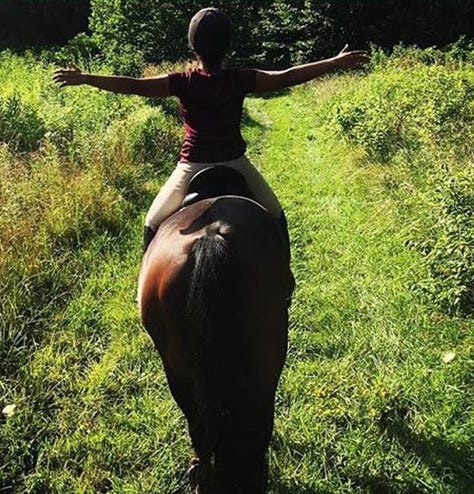
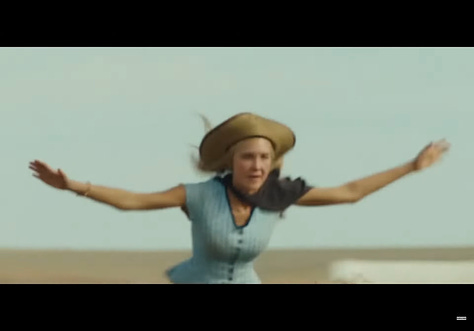
Elsa’s narration brought something to 1883 that I found moving whatever grandiose (or sometimes, too-fetching) nonsense she occasionally spouted. Through her, Sheridan abandoned the “God’s eye view,” of the trek West—almost always a male point of view—and replaced it with the subjective journey of a young woman. It’s not the Native-American’s story, but neither is it the white man’s story. And when Elsa, deferring to her mother, puts on her buttoned-up, waist-cinching white dress again—the one she’d worn in the opening scenes of the first episode, lying beside a burning wagon--we knew what was coming.
For a while it isn’t clear whether she’ll be saved or not. She has what would normally be a fatal wound. But she is young, strong, and vital, and at one point reprieve from death seems to be coming in the form of Native American healing practices. But this is not a saga where freedom and beauty are spared the “terrible”—and that, perhaps, is where the series resonated the most for me.
3. Mourning
My older sister died December 27 2021, and I went to a strange place for a year. I couldn’t go to her zoom memorial. I couldn’t write an obituary. I couldn’t open the boxes of her things that my younger sister laboriously and lovingly packed for me. I wondered what was wrong with me. Other people gather at wakes and shivas, remembering and sharing. I couldn’t look at the reminders of her all over my house without my putting a quick stop to the painful squeeze in my heart. In my underwear drawer was a pair of panties she’d left behind from her last visit. Quick, don’t look, close that drawer! In a pile of papers on my desk, her slanted, perfect 19th century handwriting. Quick; put something on top of that letter!
I tried to convince myself my sister was actually gone by creating a backyard studio dedicated to her, posting pictures on Facebook, lighting Yahrzeit candles. I tried to do the things that would allow me to see myself as a normal grieving person—and yes, I know there’s no “normal” way to grieve—but I couldn’t make her death real. Was it the flattening effect of Zoloft? Was I just selfishly protecting myself from feeling bad? Did I want to be dead myself? I was more scared of dying than ever—the calming effect of having a vital older sister “ahead of me” was gone—but where I was wasn’t exactly alive, either. Already isolated by the pandemic, I lost virtually all contact with friends. I hardly ever washed my hair. I stopped writing. My mind still swarmed with ideas. But my body simply would not sit down at the desk and put words to them. It was only much later that Irealized that my body, slowed down and reluctant to “move on,” was wiser than my always bubbling-with-stuff mind. It knew it was necessary for me to integrate the changed world—the new world, the “after” world—into the ideas and feelings that I give expression to when I write.
Sometimes we need art to help us to cry. It may be one of the main reasons humans make art. When I was 10 or so, it was Beth’s death in Little Women, as I got older it was more likely to be music. When my father died, I drove every morning from my house in Nicholasville to the University where I taught weeping over a CD of Mandy Patinkin singing “I Dreamed a Dream” from Les Miserables. When I made the break from scholarly, “objective” writing to write about my father, I cried the entire time I worked on that piece. I had never thought of myself as an artful writer, just a smart and clear one. But in writing about my father, I turned fact into saga—a tragic saga that moved even me, its creator.
Nothing in recent movies or television has honored grief the way 1883 does. People bear it on their bodies, a heavy weight that they drag along with the wagons and horses. It’s hard work to dig the many graves, but those left behind labor with what they have—a plate, a stick, hands. And they keep going, their grief written on their bodies. An ex-Union captain on the brink of suicide after his wife and daughter’s death from smallpox puts the gun down but carries his depression throughout the series. The human wreckage of the Civil War haunts both Union men and Confederates alike (Antietum or Gettysburg, it makes no difference.) Elsa loses her color-vision when her first lover is shot. When she herself dies, swaddled in the arms of her father, he changes the course of the family journey to settle on the spot she’s picked. Her mother will visit the grave every day.
These scenes, far from depicting people hardened by the constancy of loss, give a place to its emotional devastation. Not so for our culture, which is full of ceremonies but rarely gives adequate expression to the immensity of grief—especially over the unexpected, strange and relentless deaths that have invaded ordinary life this past decade.
1883 started airing the same week that my older sister died—among the reasons why I, usually on top of everything happening on television, missed reading about it completely. Until I finally watched it, nothing on television had provided anything more for me than distraction and entertainment (or anger, watching the news). Nothing had truly moved me. Nothing had honored the impossible-to-describe change in the texture of experience after the loss of part of oneself. Nothing that gave me poetry and beauty and pierced through the surreality without retreating to fantasy.
My sister’s death was neither from the tip of a poisoned arrow or from COVID. And there are vast differences between a perilous trek across the plains and lives that have medicine to counter snakebites and fevers. But there were vast differences, too, between the world of Little Women and those of a 20th century preteen. There was much that was maudlin in that book, too. Yet Beth’s death had me sobbing, and those tears, while they couldn’t change the end of the book, did restore me to myself at a time when I needed it. In the same way, 1883 cracked me open and helped me to cry—and feel again—in a world without my big sister. So I forgive the cliches about strong, silent men. I forgive the historical blunders and biases, I forgive the fact that Elsa’s hair and teeth (everyone’s teeth, for that matter) are improbably/impossibly perfect. I forgive the moments when her narration crossed the line into the cloying. And I welcomed my sobs--during a year when I (and so many others) often felt frozen in numb mourning—when she died.
If you enjoyed this piece, please consider subscribing (free or paid) to BordoLines!

